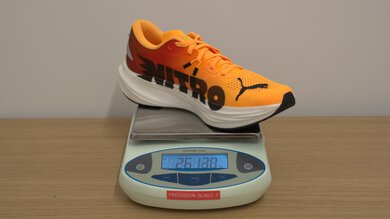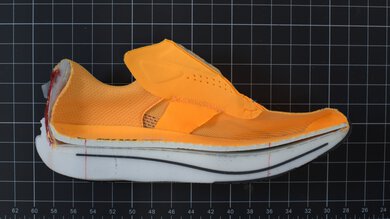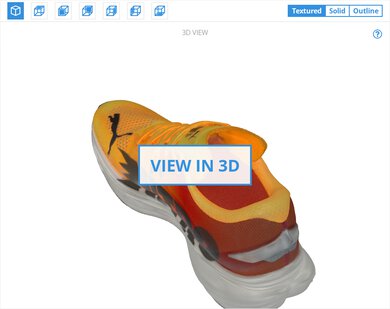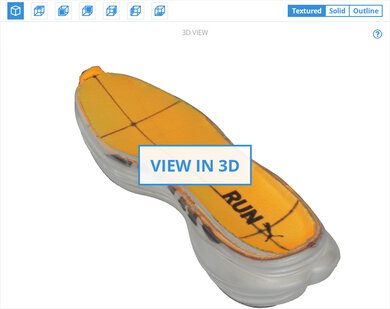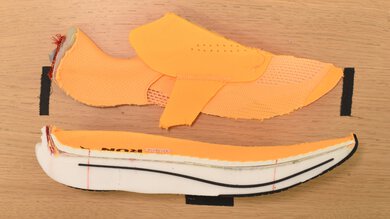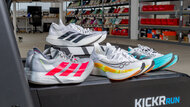The PUMA Deviate NITRO 3 is a carbon-plated trainer. Like its predecessor, its midsole is fitted with a bottom layer of PUMA's nitrogen-infused NITROFOAM and a top layer of the same TPU-based NITROFOAM ELITE found in the performance-oriented PUMA Deviate NITRO Elite 3. In between the two foams is a carbon fiber PWRPLATE to add some stability and stiffness, with PUMAGRIP rubber on the outsole for grip. Overall, it makes for a highly versatile trainer, whether you're using it for daily runs or up-tempo workouts.
Our Verdict
The PUMA Deviate NITRO 3 is okay for marathon racing, though it's primarily intended for training. That shows in its weight, which isn't quite light enough for competitive racing, and its slightly muted energy return compared to dedicated racers. On the upside, the shoe is decently cushioned, and its plate helps maintain some stability during longer efforts when form begins to break down. That said, the narrow arch can be problematic during longer runs, as the fit can be quite tight after the foot begins to swell.
-
Carbon fiber plate.
-
Decent cushioning, especially in the heel.
-
Energy return is just okay.
-
On the heavier side for racing.
-
Narrow outsole, especially in the arch.
The PUMA Deviate NITRO 3 performs well at shorter distances and makes for a good budget 5K/10K race option. It has a very firm forefoot, aided by its carbon fiber plate, which allows for energetic toe-offs. That said, the midsole's energy return is a bit lacking, and it's a bit too heavy for high-performance racing.
-
Firm forefoot.
-
Carbon fiber plate.
-
Energy return is just okay.
-
On the heavier side for racing.
The PUMA Deviate NITRO 3 has an okay energy return. It isn't the bounciest midsole, but its energy return is consistent in both the heel and forefoot, catering to different foot strikes and making for relatively smooth transitions.
-
Energy return is balanced across the heel and forefoot.
-
Energy return is just okay.
The PUMA Deviate NITRO 3 has decent cushioning. Its heel is especially good at absorbing impacts, creating a plush landing. However, the forefoot isn't quite as protective.
-
Decent cushioning, especially in the heel.
-
Forefoot cushioning is a bit lacking.
The PUMA Deviate NITRO 3 has adequate lateral stability. Its engineered upper and semi-gusseted tongue ensure good lockdown. Also, while it has a relatively high stack and soft heel, the carbon plate adds some stability to the midsole. However, it doesn't have the widest platform, and its arch is especially narrow, which can be a problem when the foot swells during longer runs.
-
Carbon fiber plate.
-
Good lockdown thanks to gusseted tongue and upper.
-
Narrow outsole, especially in the arch.
-
Heel feels quite soft.
- 6.8 Marathon Racing
- 7.7 5K/10K Racing
Performance Usages
- 6.5 Energy Return
- 7.1 Cushioning
- 6.5 Lateral Stability
Changelog
-
Updated May 14, 2025:
We updated the Compared To Other Running Shoes box to mention the PUMA Fast-R NITRO Elite 3 in the PUMA lineup.
- Updated Apr 02, 2025: Converted to Test Bench 0.8.
- Updated Apr 02, 2025: Review published.
Check Price
Differences Between Sizes And Variants
We bought and tested the PUMA Deviate NITRO 3 in men's US size 9. The model we bought is the FADE edition, which comes in a unique Sun Stream/Sunset Glow/White colorway that features a gradient design. Here's the label for our pair.
The shoe also comes in standard colorways like PUMA Black/PUMA White, Eucalyptus/Fizzy Apple, PUMA White/Feather Gray/PUMA Silver, Blue Crystal/PUMA Black, PUMA Black/Sun Stream, Cool Weather/Yellow Alert, Lapis Lazuli/Sunset Glow, Pure Magenta/Yellow Alert/PUMA White, Pale Plum/Midnight Plum/Sun Stream, and more, depending on the region and gender of the shoe.
In addition, there are a few collab variants that feature unique colors and designs, like the PUMA x ALEX TOUSSAINT edition and the PUMA x SAYSKY edition. Finally, PUMA also sells a Winterized variant that features a water-repellent coating and lace cover.
You can buy this shoe in standard or wide width.
Compared To Other Running Shoes
The PUMA Deviate NITRO 3 is designed to be the training partner for the race-day-oriented PUMA Deviate NITRO Elite 3. It sits above the entry-level PUMA Velocity NITRO 3, with more premium features, including a layer of ELITE foam and a carbon fiber plate. That carbon plate makes it stand out among other super trainers that opt for plastic or nylon plates, like the Saucony Endorphin Speed 4. However, it's held back by its weight and somewhat limited stability, particularly in the heel. Lighter options like the adidas Adizero Evo SL offer even more bounce despite lacking a plate, while more cushioned alternatives like the HOKA Mach X 2 provide more underfoot protection. Still, if the fit is right for you, the NITRO 3 is a versatile trainer that's especially well-suited to steady miles and workouts. If you're looking for a top-of-the-line lightweight super shoe for race day, check out the PUMA Fast-R NITRO Elite 3.
Check out the best running shoes we've tested for more options.
The Saucony Endorphin Speed 4 and the PUMA Deviate NITRO 3 are both plated super trainers, but they excel in different areas. The PUMA is a higher-stack shoe that offers slightly better cushioning, making it a better fit for heavier runners or those who prefer a bit more protection underfoot. The Saucony, on the other hand, is notably lighter and has better energy return, making it more efficient for speedwork despite using a nylon plate rather than a carbon fiber plate like the PUMA.
The ASICS NOVABLAST 5 and the PUMA Deviate NITRO 3 are both high-stack cushioned trainers that perform similarly despite some key differences. They both return a similar amount of energy, but the ASICS offers a more cushioned ride, making it a better choice for longer efforts and for those seeking plush comfort. The PUMA, however, feels more controlled, with a carbon fiber plate and firmer foam.
The Saucony Endorphin Pro 4 and the PUMA Deviate NITRO 3 both offer a similar level of cushioning, but they serve slightly different purposes. The Puma is a super trainer with a carbon plate, making it great for high-performance training, while the Saucony is a versatile super shoe primarily built for race day. Despite their similarities in cushioning, the Saucony is the better option for most runners since it is lighter, more stable, and more energetic, providing a snappier, race-ready feel. The Puma, while still capable of fast efforts, leans more toward durability and daily versatility rather than outright speed.
The PUMA Deviate NITRO 3 and Brooks Hyperion Max 2 are both plated super trainers built to handle faster training sessions. The Puma has a carbon plate, which is superior for racing short distances. This plate offers a stiffer, more aggressive feel. The Hyperion Max 2, meanwhile, uses a nylon plate—less aggressive but paired with a midsole that provides greater energy return, offering a bouncier ride.
The PUMA Deviate NITRO Elite 3 and the PUMA Deviate NITRO 3 cater to different types of runs despite their shared lineup. The Deviate NITRO 3 is a versatile tempo trainer, well-suited for daily miles and structured workouts, and features a firmer ride. In contrast, the Deviate NITRO Elite 3 is lighter, snappier, and more race-tuned, thanks to its full-length NITROFOAM ELITE midsole and more aggressive geometry. It's built for race-day speed, offering a more responsive and energetic feel with each stride. While the NITRO 3 can handle a variety of paces and is better for training durability, the Elite 3 is clearly the more performance-oriented option.
Test Results
The PUMA Deviate NITRO 3 is on the heavier side. It won't weigh you down too much for daily training needs, but feels noticeably heavier than alternatives like the Saucony Endorphin Speed 4 or the adidas Adizero Evo SL.
The shoe returns a fair amount of energy in the heel. It's not overly bouncy, so the ride isn't as dynamic as you get with super shoes like the PUMA Deviate NITRO Elite 3. However, it's still responsive enough to handle steady paces.
The forefoot has similar energy return. Overall, the foam, combined with the carbon plate, allows for fairly springy toe-offs, but it still lacks the propulsive, energetic feel of high-performance options.
The heel is well-cushioned. While not the most cushioned, it's quite plush, especially at higher forces, where it does a great job of absorbing impact and providing a soft landing for heel strikers.
The PUMA Deviate NITRO 3 has a fairly cushioned forefoot. It doesn't provide the most underfoot protection, especially compared to more cushioned alternatives like the HOKA Mach X 2, but it's forgiving enough to prevent overly harsh landings in the mid- and forefoot.
The heel isn't especially firm, so it lacks some stability for heel strikers and heavier runners especially. That said, at higher forces, it's about on par with other plated trainers like the Saucony Endorphin Speed 4.
The forefoot, on the other hand, is incredibly firm. The carbon fiber plate adds some stiffness here, making the shoe a good fit for those who prefer snappier, more controlled toe-offs, especially at higher intensities. However, it may feel overly rigid to those who are used to a softer forefoot.
Check Price
Comments
PUMA Deviate NITRO 3: Main Discussion
Let us know why you want us to review the product here, or encourage others to vote for this product.
This product has been merged with PUMA Men’s Deviate Nitro 3 Running Shoes, Blue Cry. Follow the discussion here.



